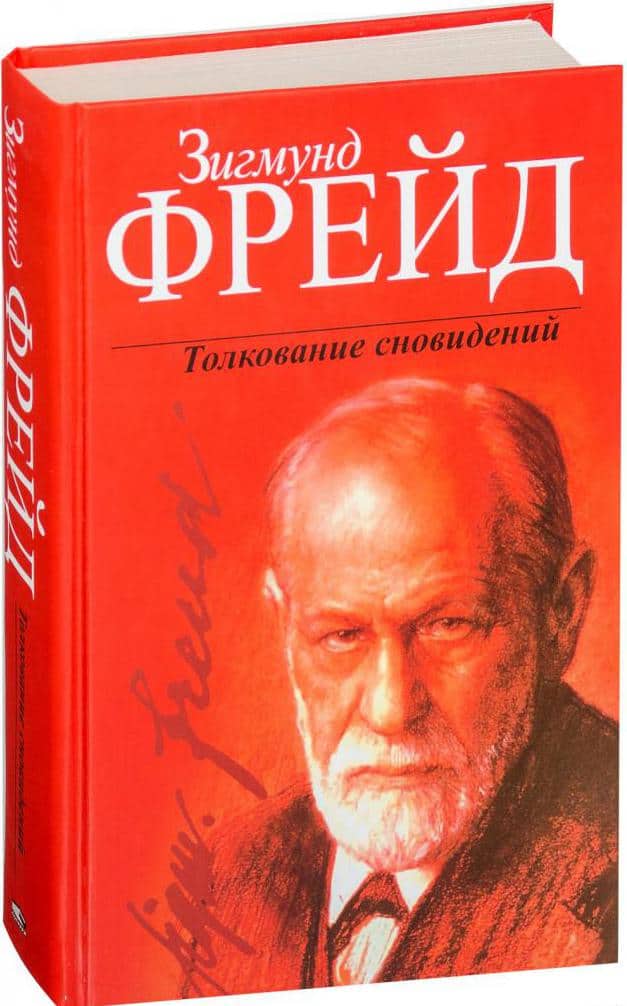Sigmund Freud (1856-1939) was an Austrian neurologist, psychiatrist and psychologist, a great innovator, and the founder of the theory of psychoanalysis.
But not everyone knows that the grandfather of psychoanalysis, as it is often called, paid great attention to the role of dreams in human life. Therefore, in 1900 the world saw Freud's Dream Book. If you are interested in learning all the features of this publication, then check out the following article.
Dream book according to Freud interpretation of dreams
Find out what awaits you today - Horoscope for today for all zodiac signs
Due to numerous requests from subscribers, we have prepared an accurate horoscope application for mobile phones. Forecasts will arrive for your zodiac sign every morning - it's impossible to miss! Download for free: Daily Horoscope 2020 (available on Android)
When a psychologist was studying hysteria, he came up with the idea to study the mysterious process of sleep. As a result, he put forward a theory about unfulfilled desires, which are often repressed by human consciousness, move into the area of the unconscious, where they remain, continuing to influence behavior.
The unconscious is an area of the psyche that is invisible to consciousness, but has a strong impact on how a person thinks and behaves in life. The process of formation of the subconscious is influenced by upbringing, psychological trauma received in childhood and negative attitudes.
Let's look at a specific example: imagine that in a girl's family, the father behaved too powerfully, authoritarianly, and did not respect the mother. Then in the future, she will unconsciously choose representatives of the stronger sex with a similar model of behavior. After all, she has a firmly ingrained attitude in her head - a man should be the head of the family.
Repressed desires strive to reach the sphere of consciousness, they begin to conflict with conscious attitudes and sometimes win, for example, when a person is in a state of sleep.
And, based on this, if you correctly decipher the dream, you can find out what unconscious experiences oppress the individual.
Therefore, Freud's dream interpreter was of great importance in psychology. He demonstrated that night dreams are by no means nonsense, but represent a repressed desire, but in a distorted, disguised form.
The famous publication “The Interpretation of Dreams” has been reprinted many times and is deservedly considered to be the main bestseller of the 20th century. True, it is surprising that the book’s popularity came a little later, and initially the dream book was received rather coolly.
Freud: dream interpretation
Sigmund Freud is a well-known Austrian psychiatrist, psychologist and neurologist. He became the founder of the psychoanalytic school, which studied the therapeutic direction in psychology. According to the postulating theory of the school, the emergence of an individual's neurotic disorders is associated with a multi-complex relationship between conscious and unconscious processes.
In the early nineties of the last century, Sigmund Freud began studying dreams. According to Freud, dreams are wishes come true. He developed this theory of dreams in 1895, in a small Viennese restaurant. The book “The Interpretation of Dreams According to Freud” was, as he believed, the milestone of his work. The theory of dreams represents a turning point in the history of psychoanalysis, because it was thanks to it that psychoanalysis was able to move on to depth psychology. According to Freud, dreams occupied a dominant place in the entire collection of psychoanalytic theories.
In 1900, the book “The Interpretation of Dreams According to Freud” was first published. By the time the first edition was published, the theory of dreams was almost completely formulated and completed. In subsequent editions, Freud only made amendments and adjustments. On the fourth and subsequent editions, Sigmund Freud worked together with his best student, Otto Rank, who compiled notes for publications, lists of references, and to the sixth chapter of the book “Interpretation of Dreams According to Freud,” he even included several articles of personal writing. Freud touches on the problem of dreams more than once, returning to it periodically. “Five Lectures on the History of Psychoanalysis,” “The Psychology of Dreams,” and “An Introduction to Psychoanalysis”—these simplified, popular expositions of Sigmund Freud’s views perfectly conveyed the general concepts and approach to the study of dreams.
In the last years of his life, Freud returned to the study of dreams. The work “Revisiting the Theory of Dreams” is a collection of additional information about dreams and makes it clear what the author considered to be the main thing in his theory, and what was secondary for him. "Dreams and Occultism" deals rather vaguely with the problems of sleep, but gives a clear understanding of Sigmund Freud's attitude to fortune telling, prophecy and astrology.
The interpretation of dreams according to Freud consists of analyzing individual elements, words and images of the dream. The dreamer must focus on what comes to mind when he thinks about a particular element of the dream. A person must be honest with himself, report everything, even the most ridiculous thoughts that arise in his head and relate to sleep. This method can be explained by the fact that psychological processes are determined, that is, if a certain object evokes some random associations in a person, they cannot be random. According to Freud, the biological basis of sleep is rest, when the human body, tired during the day, relaxes. The psychological basis of sleep is the loss of interest in everything that is happening in the outside world. According to Freud, dreams are an opportunity to distance yourself from everything earthly.
The interpretation of dreams according to Freud has several main features:
- The number of objects that are symbolically depicted in dreams is quite small.
- Most of the symbols depicted in dreams are of a sexual nature.
- Every dream contains a misunderstood point.
According to the method of free association that Sigmund Freud chose to study dreams, all human dreams are subject to the pleasure principle. This is explained by the fact that people, first of all, strive to get pleasure from life, while displeasure causes only negative, negative emotions. According to Freud, dreams can be interpreted from the point of view of several types of attraction, the fundamental ones being sexual. Eros (sexual desire) includes not only the sexual desire that is familiar to us in this understanding, but also the desire to live and continue one’s race. Another type of drive according to Freud is the death drive, which is explained by the desire of living organisms to return to a lifeless state, no matter how ridiculous it may sound to any sane person. In his works, Sigmund Freud notes that the moment a child’s sexual desire appears coincides with his birth, despite the fact that he only becomes aware of his gender in adolescence.
Having studied Freud's postulates in detail, we can come to the conclusion that he closely connects dreams and emotions experienced in reality. The interpretation of dreams according to Freud is a completely individual process, because each person experiences unique, inimitable sensations and emotions. Sigmund was convinced that all associations that did not receive worthy attention in the waking state are seen in dreams in the form of some symbols and images. According to Freud, dreams carry a certain semantic load, which is often quite difficult to analyze. In order to decipher a dream, a person must have a developed imagination and be able to think creatively.
The stage of dream symbolization is considered the most important and most difficult. According to Freud, a person fulfills his desires during sleep; sexual dreams are no exception. For example, if in a dream you see yourself eating a juicy, delicious pineapple, this means that you like to take full pleasure from sex, but ignore the desires of your partner.
Freud divided all wish dreams into several types. The first type includes desires that are infantile in nature, that is, this is a desire of an undisguised type (pronounced sexual scenes). Such dreams are most often seen by teenagers. He classified desires in a disguised form as the second type, and poorly disguised desires that a person tries to repress on a subconscious level as the third. Repressed dream-desires include nightmares. For example, if a young girl dreams of being attacked by a murderous maniac, this may mean that her desire to quickly begin to have sex was suppressed by her parents, and the desire was transformed into a dream.
Sigmund Freud's dream book is one of the most interesting and original dream books in the world existing today. Its uniqueness lies in the fact that each person will be able to interpret his dream by carefully analyzing his problems, secret desires and phobias.
Interpretation of dreams according to Freud: basic principles
The father of psychoanalysis highlighted the following principles in the process of deciphering the secrets of the subconscious:
- What has already been said - a dream is a distorted replacement of a certain suppressed desire, attitude. In a dream, this unconscious breaks out in the form of various images and signs.
- Secondly, Freud believed that dreams help a person feel as comfortable and calm as possible. In a biological sense, sleep is the body’s rest and restoration of strength.
And from the perspective of psychology, at this time a person finds himself in a state very similar to that in the womb, when there is only complete comfort and peace. And if, in addition, he also observes how his unconscious desires are embodied in life, he feels real harmony, a feeling of happiness.
- The third thing Freud talked about is that the unconscious presents its signals in the form of specific symbols, images, which are important to be able to interpret correctly. In this case, an individual approach is extremely important.
After all, two different people perceive the same symbol, say a coffee pot, in completely different ways. And when they turned to Sigmund with a request to enlighten them about what their subconscious was broadcasting, he always asked one question:
“What thoughts come to your mind about this object (or phenomenon)?”
True, the scientist subsequently understands that some symbols have the same meaning for different people. Therefore, he decides to create his famous dream book.
Today the publication is available to everyone - it can either be purchased at a bookstore, or you can find Freud’s dream book interpretation of dreams for free online on the Internet.

Dream Interpretation of Sigmund Freud
• • • • • • • • • • • • • • • • • • • • • • • • • • • “In times that we could call pre-scientific, people had no difficulty in explaining dreams.
Remembering it upon awakening, they looked at it as a good or bad omen from higher divine or demonic powers. With the flowering of natural scientific thinking, all this ingenious mythology turned into psychology, and at present only very few educated people doubt that a dream is a product of the mental activity of the dreamer himself.” (Sigmund Freud) Sigmund Freud (German: Sigmund Freud, full name: Sigismund Shlomo Freud; May 6, 1856, Freiberg (now Příbor), Czech Republic - September 23, 1939, London). Austrian psychiatrist and founder of the psychoanalytic school of psychology, a school of thought that promoted the theory that much of human behavior is governed by unconscious motives that have hidden sexual overtones. He became interested in hypnosis and its use in helping the mentally ill. He later abandoned hypnosis, preferring free association and dream analysis. These methods became the basis of psychoanalysis. Freud was also interested in what he called hysteria, now known as conversion syndrome.
Freud's Dream Interpretation
The interpretation of dreams is one of the main works of the great Sigmund Freud. Freud showed that sleep is not nonsense, but a distorted, disguised fulfillment of a repressed desire. Freud's famous dream book, which has gone through countless reprints, is rightfully considered one of the main bestsellers of the 20th century. All interpretations of the dream book according to Freud are psychological in nature and proceed from the fact that a dream, with the help of images and symbols, tells us about what is happening in a person’s life.
Sigmund Freud's fundamental work “The Interpretation of Dreams” gives an idea of the method and technique of psychoanalysis, which anticipated many of the provisions of modern dream theory. “The Interpretation of Dreams” (1900) is one of the main works of the great Austrian scientist, founder of the theory of psychoanalysis, Sigmund Freud, along with “Introduction to Psychoanalysis” (1910), “Psychopathology of Everyday Life” (1904), “I and Id” (1923) . When interpreting dreams, Freud was based on a person’s unconscious sexual desires, and therefore this dream book is sometimes called erotic. Freud distinguished 3 categories of dreams. The first category included simple dreams that do not arouse much interest because they contain elements from life and are easy to understand. Mostly children's dreams were attributed to this category. The second category included “intelligent dreams.” These dreams are endowed with a certain logic and make a person think about them. The last category included dreams that Freud considered very interesting. These are confusing, incomprehensible, meaningless dreams, but they are the ones, as Freud believed, that need to be interpreted.
Dream Interpretations: Vanga's Dream Interpretation - Miller's Dream Interpretation - Nostradamus' Dream Interpretation - Folk Dream Interpretation - Loff's Dream Interpretation
See also practice: Interpretation of dreams. This practice will allow you to learn to interpret any dreams yourself.
Return to section: Dream Interpretations
You can also:
Information
▲
() Random practice: Program - UPAZ Currently online on the site:
67 people. | Public offer | Your Yoga on social networks
Types of dreams according to Freud
According to the great psychoanalyst, there are three types of dreams:
- Understandable - not causing difficulties in the process of deciphering them.
- Logical, but strange night dreams - in some ways they are clear, but their plot is difficult to correlate with what happens in real life.
- Incoherent, confusing dreams - it is not possible to understand them. It is the category of recent dreams that deserves special attention - often the most important information about the dreamer, his life, future events, etc. is carefully encrypted in them.
Systematization of dreams in accordance with Freud's theory
The psychoanalyst identified 3 separate groups of dreams:
- Dreams that do not cause difficulties in interpretation, because they are understandable to those who see them.
- Dreams that have complex connections with events that happened in reality, but have a certain amount of logical component.
- Confused dreams that have nothing to do with real events. They are difficult to comprehend.
The last group of dreams, in accordance with Freud's work, can carry important information for a person, which will become understandable only through a detailed and complete analysis of the images.
The current edition of Freud's Dream Book contains a list of all kinds of symbols that appear as images in dreams. These symbols were analyzed and interpreted by the founder of the theory of psychoanalysis himself. The purpose of this work is to introduce ordinary people to the practical teachings of the great psychoanalyst. This work makes it possible to decode complex dreams, the causes of which are unconscious fears, repressed desires, aspirations and complexes. In this edition there is no mention of mystical images, not the slightest hint of borrowed ideas from esoteric teaching. All information presented in it is based on conclusions based on scientific experience. At the same time, the lack of information about the mystical world does not make the work of a scientist less useful and interesting for those interested in the analysis and interpretation of images from dreams.
Why do we have different dreams according to Freud's theory?
A completely logical question may arise: “If everything written above is true, a person can really realize his secret desires in a dream, why do we periodically see nightmares, stupid, inconsistent or disturbing dreams?”
This is where it gets more interesting. So, Freud said in this regard that at night, in a dream, the human consciousness, although it loses its vigilance, is still, like a watchman, “at its post.” And even in a state of sleep, a person can feel regret or annoyance associated with his manifested emotions and desires.
To protect you, the unconscious forces the conscious mind to create various meaningless pictures, scare us to death or make us cry our eyes out immediately after waking up. That is, you focus on the picture of the dream, without feeling worried about your own desires that have manifested themselves in a veiled form. This is a kind of compromise between consciousness and subconscious.
The Misunderstood Genius
Many people believe, and are often positioned, that Freud’s dream book is intimate or love, and this dream book is based on the belief that Freud interpreted dreams only from the perspective of sex. If in Freud’s psychoanalysis the theme of hidden desires is present in a large segment, then not only did he also have physiological desires in mind - he reveals the theme of unfulfilled desires in its entirety, without referring everything “below the belt.” The cliche of “a sexually preoccupied genius who sees everything only from the perspective of animal instincts”, posed more than a century ago, does not justify itself in the modern world, which has seen both the sexual revolution and the struggle for equality of sexual minorities.
Freud was simply, like many great men, ahead of his time. He wrote openly about sex, raising “indecent” topics directly in conversations with patients, but he talked about part of everyday life, about the fact that this is an equally important area in life. But he was misunderstood by many of his contemporaries, criticized by critics, but no one did more for psychological science and for psychoanalysis in general. He provided food for further work, and, perhaps, he was mistaken in some ways, due to the fact that he was a pioneer - he studied the human essence thoroughly, helping others find their lost selves.
Why have a disturbing dream according to Freud?
Separately, Sigmund Freud identified disturbing dreams. The psychoanalyst said about them that they are the result of insufficiently high-quality disguise, when suppressed desires come almost to the surface.
In addition, he called them a product of repressed sexual impulses. Here I would like to recall the numerous critics of Freud’s theory who ridicule his comparison of all symbols in dreams with either female or male genital organs.

The scientist's thinking was greatly influenced by the time in which he lived. After all, the Victorian era is known for its sanctimonious attitude towards love affairs. Freud decided to protest against such attitudes, so his preoccupation with sexual signs becomes quite understandable.
Many of the psychiatrist's theories, in particular, and the theory of dreams in the future cause even more hostility. After all, Freud persistently sees only sexual overtones in everything and he attributes everything to a person’s repressed sexuality and his secret desires.
The history of the creation of Freud's dream book
The famous Austrian scientist Sigmund Freud is rightfully considered the founder of the theory of psychoanalysis.
Freud created a number of fundamental works in which he sought to explain the essence of such a psychological phenomenon as dreams. According to his theory, human desires that could not be fulfilled are forced out of the sphere of human consciousness and move into the area of the unconscious. They are stored in the unconscious and continue to have a significant impact on human behavior in everyday life. Trying to break back into consciousness, repressed desires come into conflict with conscious attitudes and defeat them during such states of consciousness as dreams, daydreams, etc. Therefore, using the correct interpretation of symbols and dream images, one can judge a person’s unconscious experiences.
The interpretation of dreams is one of Freud's most significant works (which later became the basis for Freud's Dream Book), in which he showed that a dream is not a meaningless set of images, but a distorted and veiled realization of a repressed desire. Based on this and other works of Freud, which were devoted to the study of dreams, Freud’s dream book was compiled, which occupied a certain niche among other popular dream books of our time.
Most interpretations of Freud's dream book are tied to the sexual side of people's lives, relationships between opposite sexes. It is these aspects that underlie other works of the famous psychoanalyst. In this regard, the interpretations of Freud’s dream book may seem somewhat ambiguous, but one should not completely neglect its interpretations, if only because Freud spent more than one year of his life working on the dream book and considered it the crown of his activity.









